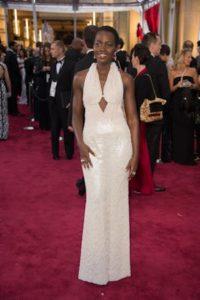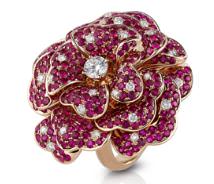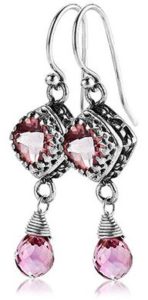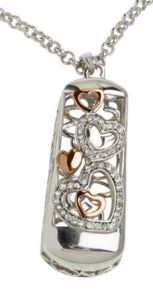Track & Translate Trends
It’s important for jewelers to follow fashion, understand its connection to jewelry, and relate the trends people are talking about to their products to help consumers develop their own style.

02
There is a tremendous amount of media devoted to fashion, especially celebrity driven, that jewelers should tap into. “The visibility is incredible, especially with the added immediacy and reach of social media,” says Michael O’Connor, jewelry stylist to the stars and Reelz Channel style correspondent. “When a celebrity wears it on the red carpet, runway or around town, the coverage will take that trend to a massive audience, pushing it exponentially resulting in greater impact.”
According to a Feb. 18, 2015 story in WWD: “Designers bask in the spike in brand awareness, and retailers say there’s a definite correlation between a celebrity wearing a designer’s [gown, accessories] and a boost in sales. While the effect might not be immediate, stars photographed on the red carpet help boost sales of similar styles [if not the exact designs], as well as other products and secondary lines. Hollywood events influence color, silhouette, jewelry, make-up, and hairstyle trends that resonate long after awards season has ended. Sometimes it even sparks a whole new category like Emma Stone’s Lanvin jumpsuit or Jennifer Aniston’s lariat.”
The article cited red carpet jewelry trends that took off in 2015 like bejeweled headbands, inspired by Lupita Nyong’o’s Fred Leighton hair accessory worn at the Academy Awards, generated some $3.2 million in earned media performance in the three months after the show. And back-worn necklaces, as Jennifer Lawrence sported at the Oscars, a trend she started in 2013, saw earned media performance jump from $1,600 in February to $10,500 in March for the category. Style experts also cited celebrity trends like brooches in the hair, ear cuffs, hand jewelry, and wearing multiple rings as mainstream popular.
“It’s how you tap into a trend that keeps you relevant and sets you apart,” says O’Connor. “You don’t need to have the exact same item to capitalize on the trend. Jewelers can use the red carpet as a platform to help customers achieve a look. Put your own spin on it—a different gem, size, or added accents.” He cites as an example, the 115-carat emerald drop earrings Angelina Jolie wore to the Oscars in 2009. Do a web search and you’ll come up with hundreds of links to green color earrings reminiscent of the drops. It’s an iconic look.”
Consider these tips to better track and translate trends that will get you in on the conversation and establish you as style expert:
 • Involve Your Staff. Find sales associates with a passion for fashion to follow and report on trends and how they relate to your merchandise and clientele at regular meetings, advises Amanda Gizzi, director of public relations for Jewelers of America. “Scour coverage of fashion shows, watch major red carpet events, follow Pantone’s predictions, and read jewelry trade and consumer lifestyle magazines in print and online that summarize what’s happening.”
• Involve Your Staff. Find sales associates with a passion for fashion to follow and report on trends and how they relate to your merchandise and clientele at regular meetings, advises Amanda Gizzi, director of public relations for Jewelers of America. “Scour coverage of fashion shows, watch major red carpet events, follow Pantone’s predictions, and read jewelry trade and consumer lifestyle magazines in print and online that summarize what’s happening.”
 Lifestyle magazines, notably People, InStyle, and Us Weekly offer good directional cues, cites O’Connor. Also, consult with your vendors for market insights, and perform simple web and social media searches as a quick and easy way to track trends. According to business.com, Feedly, Pulse, Moz, Top 10, and Hacker News are good news and trends aggregates for any industry.
Lifestyle magazines, notably People, InStyle, and Us Weekly offer good directional cues, cites O’Connor. Also, consult with your vendors for market insights, and perform simple web and social media searches as a quick and easy way to track trends. According to business.com, Feedly, Pulse, Moz, Top 10, and Hacker News are good news and trends aggregates for any industry.
• Show and Tell. A picture speaks a thousand words, and that value goes a long way if you pitch the story right, says Rebecca Foerster, executive vice president, strategic planning and marketing for Leo Schachter Diamonds, New York. She advocates jewelers buy runway and red carpet images that demonstrate trends that speak to their products. “Use images in store and online to engage conversation and share style insights. It’s one the easiest ways to further your cache as a style expert.”
O’Connor suggests jewelers merchandise products from a story perspective, not by category. “Find different ways to help your customers visualize the possibilities as they relate to outfits and occasions. Consumers love to see things put together.” To that end, consider promoting a trunk show that curates top trends spied at New York fashion week or a major red carpet event like the Oscars. Most importantly, teach customers how to layer their jewelry, advocates Atlanta-based designer, Sara Blaine, a Benchmark partner. “Consumers want to know how to look at their jewelry to wear in ways that speak to their signature style. It’s all about realizing what you can do with your jewelry.”
• Keep It Fresh. In our ever-evolving digital world, content is king, and Compatible Cropped content relating popular runway and red carpet trends to your products will help consumers identify ways to achieve their favorite looks. Mark Hanna, CMO for Richline, New York advocates jewelers invite guest editors, bloggers and style experts to write on fashion and accessory trends to broaden their outreach. Gold jewelry and wearable tech are two major categories Richline blogs about, successfully employing these tactics. Ask sales associates, too, to blog about products they love, and pick designs they deem must haves for the season, giving them a chance to share their passions and build their style bona fides.
Compatible Cropped content relating popular runway and red carpet trends to your products will help consumers identify ways to achieve their favorite looks. Mark Hanna, CMO for Richline, New York advocates jewelers invite guest editors, bloggers and style experts to write on fashion and accessory trends to broaden their outreach. Gold jewelry and wearable tech are two major categories Richline blogs about, successfully employing these tactics. Ask sales associates, too, to blog about products they love, and pick designs they deem must haves for the season, giving them a chance to share their passions and build their style bona fides.
Savvy jewelers who work off of cues from the runways and red carpets can excite and inspire consumers to shop for their own version of glamour.










